
Bosigran is a large granite sea-cliff located in West Penwith at the very tip of the Cornish peninsula and, along with the nearby Great Zawn, it holds some of the UK's greatest and most cherished rock climbs. West Penwith is an astoundingly special place with its physical ambience and intermingling of stark moors, pounding seas, peaceful coves and gorgeous beaches. Add to these attributes a rich celtic and maritime history and you have the key ingredients that go into making climbing in the vicinity of Bosigran such a memorable experience.
Bosigran
Bosigran is a large, heavily-featured traditional granite sea-cliff perched high above a boulder-strewn cove and, more often than not, a boiling cauldron of icy blue Atlantic waters. However, this is not a wholly accurate picture as the main cliff itself is in reality way above the clutches of even the highest of spring tides or wild seas.
Bosigran is a crag suited to all; from those just starting out, to long time aficionado's. Being close to the western tip of Cornwall, a visit to Bosigran for most will require a bit of a journey hence it tends to be sampled as part of a climbing holiday. Après-climbing activities ranging from surfing and sunbathing to eating pasties and drinking cider make a welcome break from climbing, especially if the body has been ravaged by the frequently physical nature of the routes, but eventually you are sure to be tempted back onto the rock.
The tide-less nature of many of the routes at Bosigran is a big plus and allows a certain amount of flexibility whilst in the region, routes being slotted in around the varying access to the majority of the other sea cliffs dotted along the coast.

Bosigran - The Main Cliff
Immediately the carpark is entered the mood is set, the old Carn Galver mine ruins and the remote Count House evoking a sense of the past and pointing the way to the as yet hidden cliffs. A stroll through walled-fields reveals the confines of Porthmoina Cove and the serrated Bosigran Ridge a.k.a Commando Ridge (VD) a.k.a Commando Ridge (VDiff) to its west. The contouring path suddenly exposes the sheer profile of the Main Cliff.
For the most part the climbing at The Main Cliff is not serious with the bulk of the classics being well protected and on clean and super-solid granite. Terra firma is only an abseil away and the path and ledges beneath the crag are very accommodating, although narrow and awkward in a couple of spots. A word of caution to the uninitiated is the feel of the granite routes at their respective grades which on first acquaintance can seem under graded. The best approach is to test the water from a safe distance with a grade or two in hand and to tell yourself it's good practice for Yosemite where the grades really are solid!
The initial section of crag is very friendly in nature and possess a good number of easy routes, the most trodden being the three pitch Alison Rib (D) (Diff) and its equally amenable neighbour Oread (HVD) (HVD). Moving further seaward, beyond the descent gully, the crag now takes on a more imposing look but still provides a superb easy expedition in the guise of the four pitch Ledge Climb (HVD) (HVD). Bisecting Ledge Climb are two legendary routes. The operatic Anvil Chorus (VS 4c) (VS 4b,4c) has a fearsome reputation for spitting out the unfit from its crux layback crack but in compensation the crack eats up protection. The second legend Little Brown Jug (VS 5a) (VS 4b,4a,5a) is even better; its outrageously-positioned final pitch is not a place for those unsure at the grade but is nevertheless one of the finest VS pitches in Britain.
The long right-to-left line of Doorway (S 4a) (Severe) is another first rate multipitch excursion that heads for, and then exits up, the prominent corner high on the face just before the curving line of the famous Joe Brown extreme Bow Wall (E2 5b). Venturing close to Bow Wall is the all-time Bosigran favourite and archetypal Cornish granite classic Doorpost (HS 4b) (HS 4a,4b,4a), its three high quality pitches proving technical, strenuous and exposed in about equal measure. A direct start taking the appealing thin cracks in the lower wall is the intense first pitch of Thin Wall Special (E1 5b) (E1 5b). The above-mentioned Bow Wall (E2 5b) (E2 5b,5b) is on the 'most wanted' list of many visitors and usually extracts its pound of flesh on the committing crux manoeuvres to gain the very exposed midway stance.
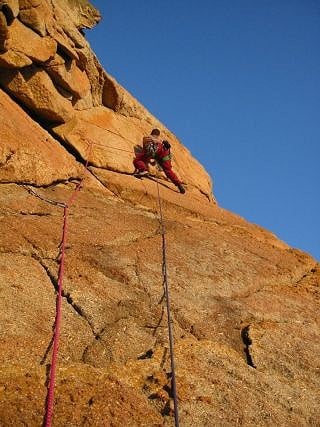
The section of face to the left of Bow Wall is massively impressive and has a host of extreme lines, some direct and others linking the odd chink in the crags formidable defences. The easiest (but not that easy!) way up this area of rock is via Suicide Wall (E1 5c) (E1 -,4b,5a,5c,4b) which traverses both thin and wide cracks and powers up short hard walls. Equally unforgettable is the counter line of The Ghost (E3 5b) (E3 5a,5b) which takes on the daunting high-level roofs, managing to side step the most steep section via a heart-in-mouth rightwards traverse with toes on the last inches of rock above a huge drop. Even harder climbs such as Morgawr (E6 6c) (E6 5b,6c), Shaft (E3 6b) (E3 5c,6a), Vulcan (E5 6b) (E5 5a,6b), The Phantom (E3 6a) (E3 5a,5c,6a) and The Absolution (E6 6c) (E6 5a,6a,6c) find their way more directly to and through the upper overhangs but, given the relatively amenable grade of The Ghost, none are anywhere near as popular.
As the upper overhangs diminish the wall once again changes in character, this time criss-crossed by slim corner-grooves, ramps, wide cracks and flakes, both vertical and horizontal. Beowulf (E2 5c) (E2 5a,5c,5b) and close by Paragon (HVS 5a) (HVS 5a,4c,5a,5a) are typical of the style on this section with diverse technically challenging pitches that, although short-lived, leave a lasting impression. The shallow corner on the second pitch of Beowulf being a very good example of these pitches, where strong-arm tactics play little part in a achieving a successful outcome. As the rock becomes better featured the climbing becomes less sustained and more in the way of a rhythm can be found Nameless (VS 4c) (VS 4b,4c), Zig Zag (VS 4c) (VS 4c,4c) and Autumn Flakes (HS 4b) (HS 4a,4a,4b) all falling into this category.
The crag now starts to lose height and the routes become single pitch with large comfortable belays from which to watch the goings on above. The reduction in height is balanced out by the steepening rock and dramatic lines. The routes here are hard and uncompromising but unlikely to be forgotten in a hurry. Kafoozalem (E4 6a)(E3 6a), Raven Wall (E3 5c)(E3 5c), Grendel (E2 5c) (E2 5c,), Patience (E3 5c) (E3 5c) and Evil Eye (E5 6b) (E5 6b) are some of the Westcountry's greatest and should you tire of these the fillers-in of Dominator (E2 5c) (E3 5c) and Pump It Up (E3 6a) (E4 6b) are worthy interlopers. Only Beaker Route (HVS 5a) (HVS 5a,5a) and The Armchair (HVS 5a) (HVS 5a,5a) allow the wall to be sampled at a more friendly level, although more lower to mid grade routes lie down on the Seaward Cliff.
Bosigran - The Seaward Cliff
The first section of the Seaward Cliff is also non-tidal and is again multi-pitch territory but the base is closer to the sea and more prone to spray in heavy seas. Black Slab (D)(Diff) is a tremendous route with impeccable position and rock. Just left are the starts of Ochre Slab Route I (HVS 5a) (HVS 4c, 5a) and Ochre Slab Route II (S 4a) (Severe 4a,4a) both worthy of anyone's attention providing both delicate and strenuous manoeuvres as well as being useful alternatives if the more accessible routes on the Main Cliff itself are busy. If more action is desired in this area then Ding (VS 4c) (VS 4c,4b) and Dong (S 4b) (Severe) provide equally engaging pitches all on superb granite. Out of sight around the corner, and on the only true section of sea cliff at the Main Cliff area, are quite a few routes with a slightly serious feel about them due to the paucity of gear hereabouts. For those looking for a some real solitude and a dose of adrenaline, Geronimo (E1 5c) (E1 5c,-) is the route to get an idea of what's in store.
Bosigran Ridge Area
Across Porthmoina Cove is the serrated 'alpine-like' Bosigran Ridge a.k.a Commando Ridge (VD) (VDiff). At around 700ft in length, this is one of the UK's classic outings at the grade with fine views and atmosphere. The ridge starts down at sea-level and progresses up the ridge via cracks, walls, chimneys, aretes and slabs to finish at the point where the descent started. The ridge is often also reffered to as Commando Ridge due to it having being used for training by the Cliff Assualt Wing back in the days. On the descent to the base of the ridge is a charming almost non-tidal wall with a half dozen lines of which Gallipoli (E1 5c) (E1 5c) is the best and an exquisite pitch. There has been some recent development here and a free PDf can be downloaded from the Rockfax site. 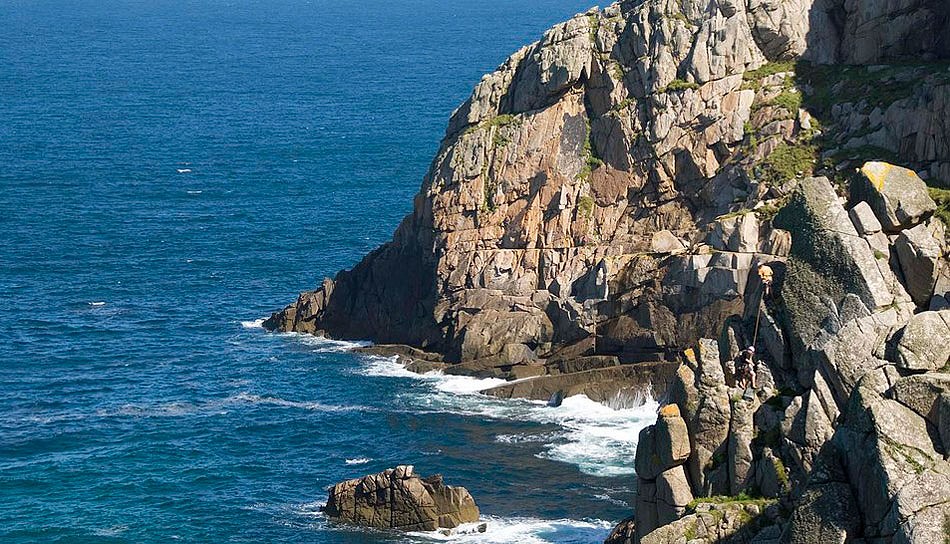
Great Zawn
Just around the corner from Bosigran Ridge is the awesome slit of Great Zawn, which although virtually non-tidal is a serious spot that requires an abseil and a committing jump across a wide gap to reach the Seaward Face. Here lie the cream of Cornwall's hard granite routes such as Dream Liberator (22) (E3 6a,5c), Déjà Vu (E4 5c) (E4 5c) and The West Face (E5 6b)(E5 5c,6b,4a) - all superb and give climbing to match anything elsewhere in the UK. On its East Wall is the sustained Xanadu (E2 5b) (E2 5b,5b,5b), whilst Desolation Row (E2 5b) and The Variety Show (HVS 5a) (HVS 5a,4b) are very probably the most-travelled lines being a bit steadier and single pitch. 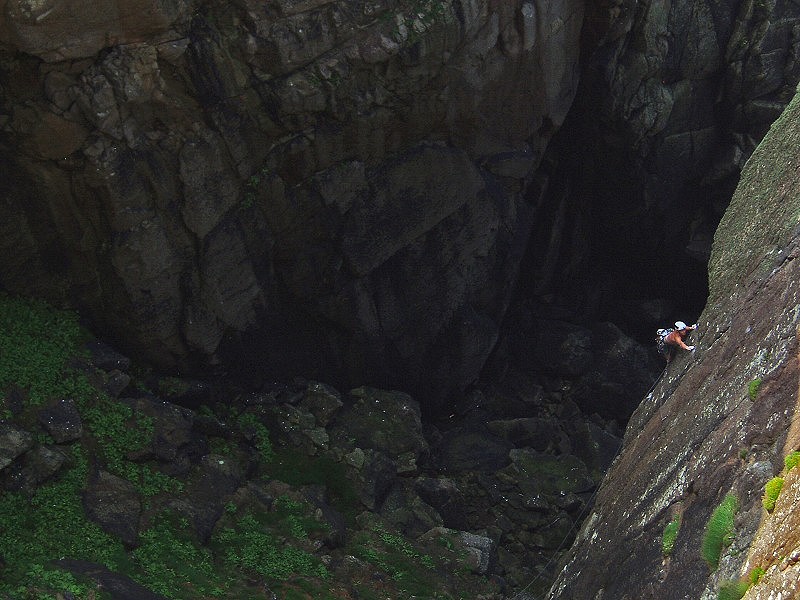
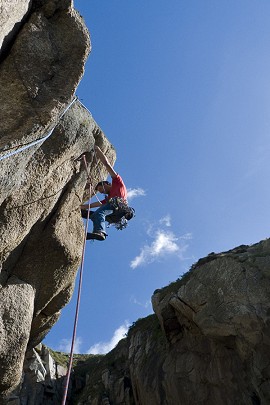
The very best climb in the Great Zawn is the combination of the first pitch of the route Dream combined with the top pitch of the route Liberator. UKC Editor Jack Geldard gives a brief but illuminating account of his ascent.
"Well it all starts with a leap of faith!
I had climbed Green Cormorant Face, the classic E2, ten years previous and the two things I have never forgotten are that dreaded jump and of course a Fulmar puking right in Owen's unsuspecting face. How he wailed. And... how he stank.
But anyway, Dream/Liberator, that's what I am supposed to be talking about. And a dreamy route it is too. Overall I found it quite tough for E3 as the freezing wind whipped away any feeling from my fingers and the cold of the shade made sure the rock was suitably greasy, though good conditions may tip the scales in the other direction. Wait for the afternoon sun to dry and warm the face, you wont regret it.
A wonderfully balancy slab leads to the jutting roof, which is overcome with some gymnastic grunting and a fair bit of panting. Don't fear – the rock above is the right side of vertical, and small wires can be wiggled, a much happier place!
The top pitch has an 'exhilarating' traverse right under another roof, but it is friendly in comparison to the first, the foot holds just perfect, the laybacks nicely solid, the position suitably pant-filling.
A fantastic route and more than worthy of its legendary status. Enjoy!"
Logistics
When to Go
Summer is prime holiday season and the crags, including all the Zawns, are usually in top condition. Spring and autumn are if anything a little better as the crowd are not in evidence although the sea in Spring is very cold, and lingering winter seepage can be a problem in the Zawns. Winter is much less reliable but is still worth a punt for the adventurous. Most of Bosigran faces generally west and receives plenty of afternoon sun. The depths of the Great Zawn gets much less sun and can be a cool retreat in hot weather.
How to Get There
Bosigran is located on the north coast of West Penwith, West Cornwall. The parking for the path to the Bosigran crags is at the roadside Carn Galver mine ruins between the hamlets of Zennor and Morvah on the B3306 that runs between St Ives and St Just. By road via the M5 to Exeter and then the A30 to Penzance. On entering the outskirts of Penzance follow signs to Lands End and then at a roundabout take signs to Madron and then Morvah.
Guidebook
Guidebook coverage of Bosigran is good. The most recent is the West Country Climbs Rockfax. This is a selective guide and ideal for visitors to the area.
Instructor/Guides Advertise here
No Premier Listings found in this area
Gear
A good size rack of wires and cams plus double ropes and a helmet. Extra cams will be found to be a very handy addition. The descent into Great Zawn requires an abseil approach. A windproof and sunscreen will be about the best protection from the elements.
Outdoor Shops Advertise here
No Premier Listings found in this area
Accommodation Advertise here
No Premier Listings found in this area
Campsites, B&B's and holiday cottages are numerous. A good campsite is at Trewellard not far from Bosigran and a very nice private hostel is located at Zennor. The Count House is a Climbers Club Hut next to the Carn Galver mine and can be booked by BMC clubs.
Food
Good food is available at The Tinner's Arms at Zennor, The Queens Arms at Bottalack, The Gurnards Head Inn and at The Meadery and Miners Arms at Trewellard. The Radjel and North Inn at Pendeen are also good pubs.
Gear and Supplies
There are two large supermarkets in Penzance. Small food shops are located in Pendeen and St Just. There are no climbing shops within an easy drive of Bosigran.
Other Activities
Cornwall is England's most popular holiday area so take your choice. Beaches, surfing, coastal walking, tea shops, tin mines, seaside towns with all that they offer, the Eden Centre and endless smaller attractions ... but you came to go climbing didn't you?

- REVIEW: Virgin on Insanity by Steve Bell 15 Jul, 2016
- REVIEW: Edelrid Jay II and Jayne Harnesses 12 Jan, 2015
- ARTICLE: Five of the best VS Routes in the UK? 1 Dec, 2014
- REVIEW: Sherpa Lakpa Rita and KritiTech Shell Jackets 27 Oct, 2014
- REVIEW: Inner Hebrides and Arran Guidebook 4 Jul, 2014
- The Primus ExpressLander Stove 8 Feb, 2013
- The Beta Stick Compact 30 Nov, 2012
- REVIEW: Locking Gate Karabiners With Added Safety Features 27 Nov, 2012
- World Climbing: Rock Odyssey by Simon Carter 13 Mar, 2012
- The Evolv Shaman Rock Shoe 6 Jan, 2012



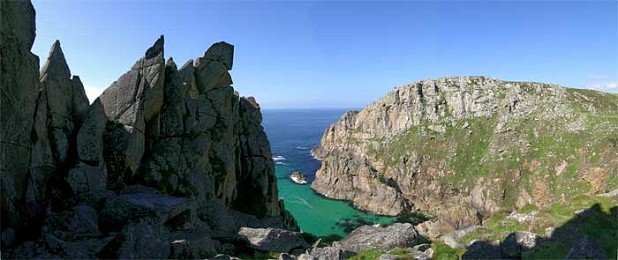

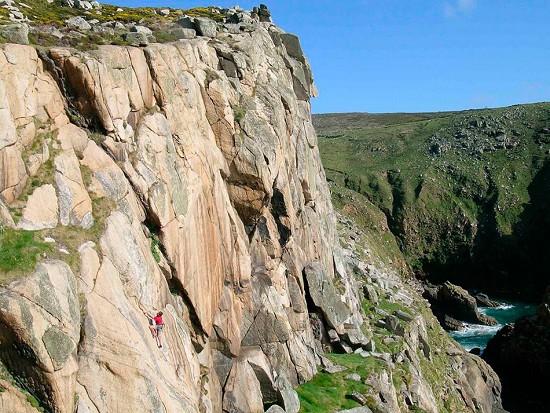
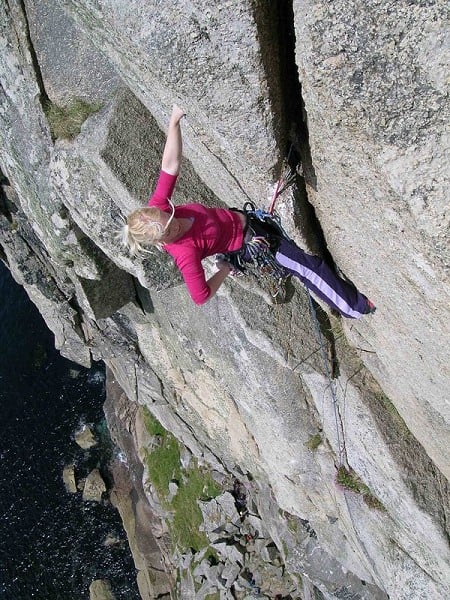
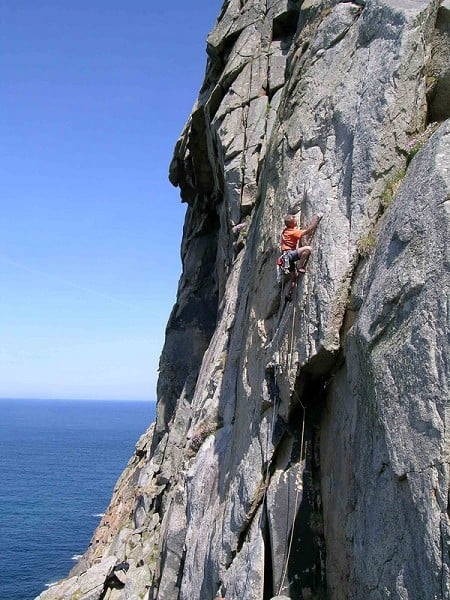
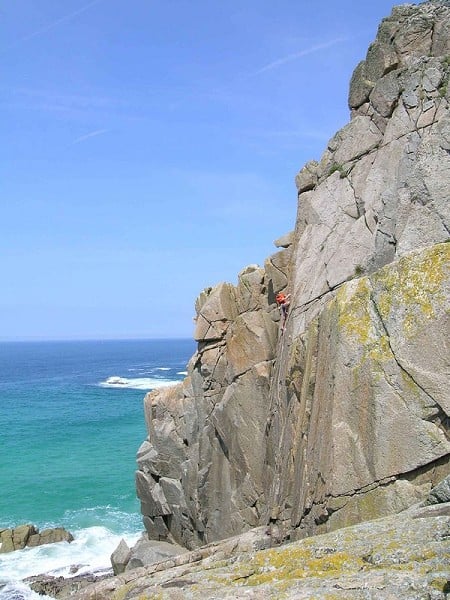
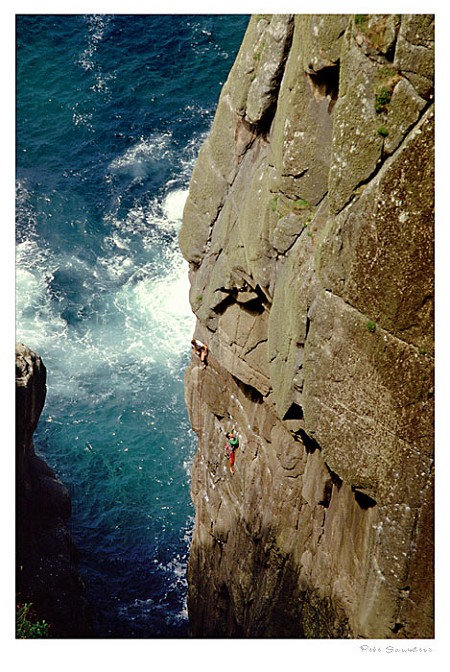
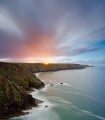
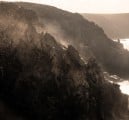
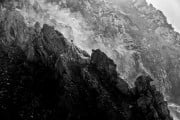
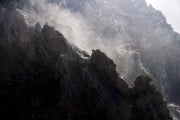

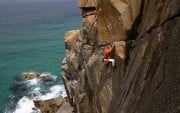





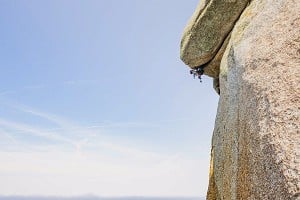
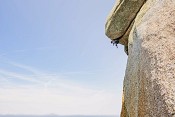
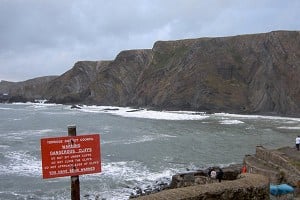
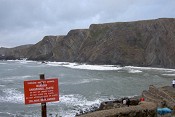



Comments